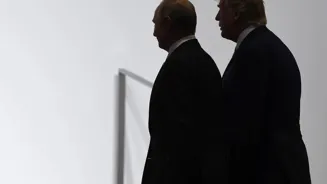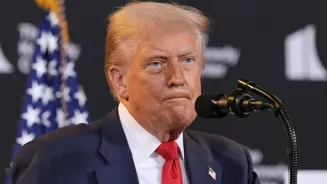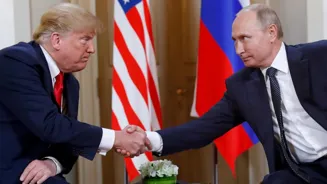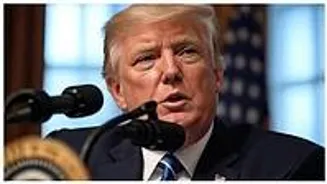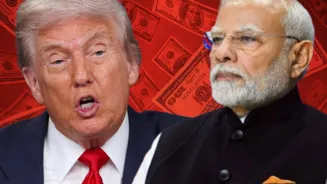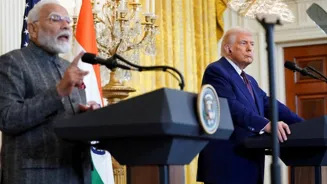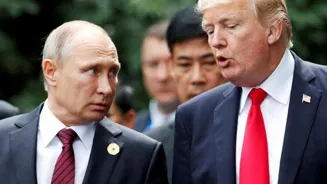Trump’s claim: Tariffs as a strategic lever
Speaking on Fox Radio’s Brian
According to Bloomberg, the tariffs, totalling
Secondary tariffs and the Putin equation
US Treasury Secretary Scott Bessent reinforced this link in an interview with Bloomberg, observing that Washington had expected Putin to come to the table “in a more fulsome way” and that
Bessent stressed that sanctions and tariffs were flexible — they could be increased, reduced or made indefinite. He also referenced the “Russian shadow fleet” of tankers operating globally, suggesting that Washington might intensify enforcement against them. His broader point was that the tariffs on India were not simply about trade disputes but about geopolitical positioning,
India’s energy trade with US and Russia
The tariffs came despite a notable shift in India’s energy imports in Washington’s favour. According to official figures, Indian oil and gas imports from the US surged 51 per cent between January and June this year, a report in The Statesman said. LNG imports from the US nearly doubled year-on-year, rising to $2.46 billion in 2024–25 from $1.41 billion in the previous financial year.
In February, Prime Minister Narendra Modi had assured that India would increase its energy imports from the US to $25 billion in 2025, up from $15 billion in 2024, specifically to help reduce America’s trade deficit — a stated goal of Trump’s trade policy. This commitment was followed by discussions between Indian state-owned oil companies and US suppliers for long-term purchase agreements.
India’s defence: Policy consistency and price math
From New Delhi’s perspective, its purchases of Russian oil
India has also pointed out that Washington still continues to import certain commodities from Russia, including fertilisers, chemicals, uranium and palladium. Moreover, New Delhi has emphasised that energy import
Strategic ties beyond trade
India’s Ministry of External Affairs has characterised the targeting of Indian imports as “unjustified and unreasonable”, a Bloombergreport said. India has repeatedly reiterated that its US relations are “multi-layered” and rest on strategic and geopolitical foundations beyond trade disputes. In a briefing to the Parliamentary Standing
This diplomatic posture appears aimed at preserving the broader bilateral relationship even while contesting the fairness of the tariffs. New Delhi’s position underscores that it sees Washington as a long-term partner, even if short-term disputes flare.
Alaska summit: Leverage in action
The Alaska meeting between Trump and Putin is set
Trump acknowledged the risk of failure, estimating a 25 per cent chance that
The China factor
While India has been singled out in recent days, China remains Russia’s largest oil buyer. Asked about Beijing’s role, Bessent avoided direct commentary but reiterated that Trump was adept at creating leverage and keeping “all options on the table.” He recalled a moment at the G7 summit in Canada when he
Bessent’s comments suggested that the administration sees secondary tariffs not just as punitive trade measures but as tools for orchestrating broader geopolitical pressure. By targeting India — a country with significant oil trade with Russia but also deepening ties with the US — Washington may be testing both its ability to influence Moscow
India’s balancing act
For India, the challenge lies in maintaining strategic autonomy while handling intensifying pressure from both Washington and Moscow. The country has long positioned itself as a balancing power, purchasing arms and energy from Russia while cultivating defence and technology partnerships with the US.
Indian has been careful to point out that the country’s energy security depends on stable, affordable supplies, which in turn require flexibility
At the same time, the expansion of US energy imports has been a deliberate effort to strengthen economic ties with Washington — a point New Delhi may quietly expect to weigh in its favour as tariff disputes unfold.
Potential fallout if talks fail
If the Alaska talks do not yield progress, Bessent’s warning that tariffs could rise further could put India in a more
Such escalation could also test India’s willingness to continue aligning with US positions on issues like the Indo-Pacific security framework or technology cooperation. While New Delhi has stressed the independence of its foreign policy, sustained economic pressure from Washington might force more overt recalibrations.
A calculated gamble by Washington
From Washington’s perspective, linking the India tariffs to the Putin talks is a calculated gamble. The move risks alienating a strategic partner, but it also highlights a willingness to use every available lever to influence Moscow’s calculus on Ukraine. Trump’s framing — that losing India as a buyer would significantly hurt Russia — rests on the assumption that the economic impact will translate into political flexibility.
Whether this proves true
India as an unintended fulcrum
As Trump and Putin sit down in Alaska, India’s role in the global oil trade has unexpectedly become a key element of US strategy. Tariffs ostensibly aimed at trade imbalances have been repurposed into geopolitical bargaining chips, with Washington betting
For India, this development highlights both its growing importance in global energy markets and the risks of being caught in the crossfire of great-power rivalry. While New Delhi continues to emphasise the strategic breadth of its partnership with Washington, it is clear that economic measures tied to third-party conflicts can quickly complicate even the most carefully managed bilateral ties.
The Alaska talks may ultimately be remembered for their substantive progress — or lack thereof — on Ukraine. But in the run-up, they have already showcased how India, without being at the table, has become a quiet yet central player in one of the most consequential geopolitical negotiations of the year.


